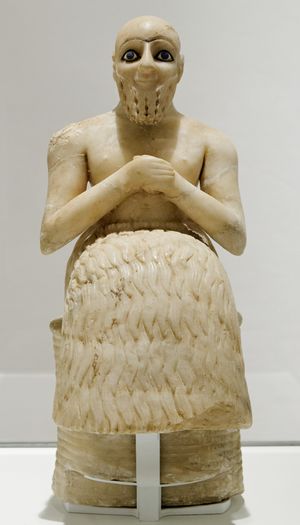كوناكس
كوناكس Kaunakes، من الكلمة اليونانية التي تعني "إزار كثيف"، ويُعرف أيضاً بإسم پرسيس persis، كان إزار صوفي أو دثار كان مستخدماً في الحضارة السومرية حوالي 2500 ق.م. وكان مغزولاً في نمط من الرقاع مما يوحي بشكل بتيلات أو ريش متراكب، إما بخياطة الرقاع لتصبح قماشاً أو بغزل حلقات لضمان التفاف القماش.
التاريخ
The origin of this dress is traced to the Sumerian civilization which existed even before 4000 BC. The period between 2700 and 2350 BC of this civilization was marked by high culture. The dress was a unisex garment which both men and women wore. The skirt was made from sheepskin and was worn with the skin turned inside and with tufts ornamented like a toothed-comb over the wool. It was used in the form of a wraparound skirt tied and worn from the waist extending to the knees.[1] Servants and soldiers wore the shortest garments, while persons of high status wore longer ones[2] with the skirt often extending down to the ankles. The upper part of the body was either covered with another cloak spread across the shoulders, made of sheepskin or left bare. It was only around 2500 BC that the sheepskin garment was replaced by a textile made of woven wool; however the tuft part of the dress was continued in the form of "sewing tufts onto the garment or by weaving loops into the fabric". The Greeks called this dress kaunakes. This type of dress is featured in sculptures and mosaics of this period; the archaeological excavations at Ur revealed this dress, which is now an exhibit in the British Museum in London.[1]
الهامش
- ^ أ ب "Dress". Encyclopedia Britannica. Retrieved 30 November 2015.
- ^ Tortora & Eubank 2010, p. 24.
المصادر
- Legrain, L. (1940). "Book Reviews: Le Kaunakès by Emile Cherblanc". American Journal of Archaeology. 44 (1): 150–2. JSTOR 499598.
- Crawford, O. G. S. (1926). "The Birthplace of Civilization". Geographical Review. 16 (1): 73–81. JSTOR 208504.
- Corbiau, Simone (1936). "Sumerian Dress Lengths as Chronological Data. An Indo-Sumerian Cylinder". Iraq. 3 (1): 97–103. JSTOR 4241588.
- Langdon, S. (2011). "V.—Sumerian Origins and Racial Characteristics". Archaeologia. 70: 145–54. doi:10.1017/S0261340900011061.
- Taha, Munir Y. (1973). "The Authenticity of a Sumerian Statue". Iraq. 35 (2): 151–3. doi:10.2307/4199962. JSTOR 4199962.
- Dimand, Maurice S. (June 1945). "A Sumerian Sculpture of the Third Millennium B.C.". The Metropolitan Museum of Art Bulletin. 3 (10): 253–6. JSTOR 3257188.
ببليوگرافيا
- Forbes, R. J. (1971). studies in ancient technology. Brill Archive. p. 9. GGKEY:R5RHS1HQD3Z.
{{cite book}}: Invalid|ref=harv(help) - Miller, Margaret C. (19 August 2004). Athens and Persia in the Fifth Century BC: A Study in Cultural Receptivity. Cambridge University Press. ISBN 978-0-521-60758-2.
{{cite book}}: Invalid|ref=harv(help) - Tortora, Phyllis G.; Eubank, Keith (2010). Survey of Historic Costume. New York: A&C Black. ISBN 978-1-56367-806-6.
{{cite book}}: Invalid|ref=harv(help)
وصلات خارجية
 Media related to Kaunakes at Wikimedia Commons
Media related to Kaunakes at Wikimedia Commons
